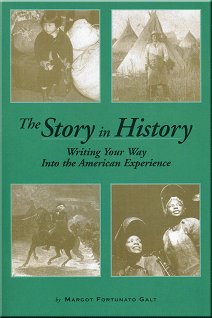More resources for teachers…
“They encourage students from many lands and experiences to speak out of what they know.”
The Story in History came first. Like its companion, Circuit Writer, it contains step-by-step suggestions for a creative experience. It includes literature that models forms and styles, comparisons and rhythms. Good models! They take writers by the hand and say, “Here’s what to do first. Try this next. Add this,” and so on. “Read what you wrote. Add this, or that.” These are very bossy directions. But kind too. Build on them, rearrange them. Try things your own way.
Particularly important for groups whose stories have been submerged or denied, these books identify traditions and forbearers. They aim to encourage expression from different groups–African Americans, Native Americans, newly arrived Somalis, long-time residents from Laos. These books spread their arms wide to encourage people of many different races, beliefs, languages, histories, to give voice. Then to step into others’ shoes. Why shouldn’t a white girl from Norwegian-American parents imagine herself sitting beside Rosa Parks on the bus? Why shouldn’t a Japanese students imagine American officials who interned their Japanese-American relatives during World War II?
Why shouldn’t a white girl from Norwegian-American parents imagine herself sitting beside Rosa Parks on the bus? Why shouldn’t a Japanese students imagine American officials who interned their Japanese-American relatives during World War II?
Writing isn’t supposed to glide over what is difficult or strange. It’s supposed to create description so riveting and true that everyone, no matter what color or heritage, will stop and listen.
Feel free to adjust my suggestions to fit your style and students. Bring in new models. Help us learn about problems we didn’t know about before. Students sometimes live lives that shock and trouble us. Look for ways to give them voice, write and read aloud their truths. I can’t think of a better way to mold unify among diversity, and help those who feel forlorn and abused believe that somewhere, someone cares.
Education
2007 Margot Fortunato Galt
Education, Memoir
2006 Margot Fortunato Galt









